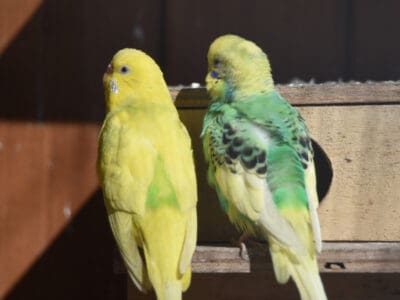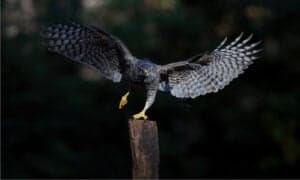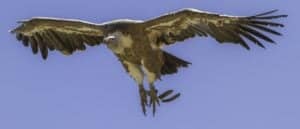Junco vs Chickadee: What Are the Differences?
Small birds can be very hard to tell apart. They are quick, skittish, and share similar traits. However, when you have the time to examine each bird for its unique characteristics, you can find enough differences to confidently state the creature’s identity. We are going to try to cultivate that level of familiarity by looking at a comparison between a junco and a chickadee.
By focusing on six key differences between these types of birds, we’ll help you learn what makes these birds unique.
Comparing a Junco and a Chickadee

A-Z-Animals.com
| Junco | Chickadee | |
|---|---|---|
| Size | Weight: 0.5-1.06 oz Length: 5.1- 6.9 in |
Weight: 0.3 to 0.4 oz Length: 2.4-5.9 in |
| Morphology | – Can have a black patch on the top of its head – Sometimes has one solid color on the head and neck – Usually lacks the white streaks on the side of its face – White breast – Pink beak – Puffy appearance |
– May have a head cap or dark-colored patch that is black or gray – Dark throat patch – White breast – Light-colored streaks on the face with markings on the tail – Dark or black beak |
| Location | – North America – Migrates |
– North America, Europe, and Asia – Typically, they do not migrate |
| Call | – Simply chips and trills several notes for a few seconds at a time | – Alarm call is often written as “chick-a-dee-dee-dee” |
| Genus | – Junco – Five different species and subspecies |
– Poecile – Several species, but not all of them are referred to as chickadee – Outside of the U.S., they are called tits. |
| Diet | – Insects and seeds – They do not cache food – Forages for food |
– Granivorous, but also eat insects, fruits, and nuts – Creates caches of seeds throughout their range to survive the winter |
The 6 Key Differences Between a Junco vs Chickadee
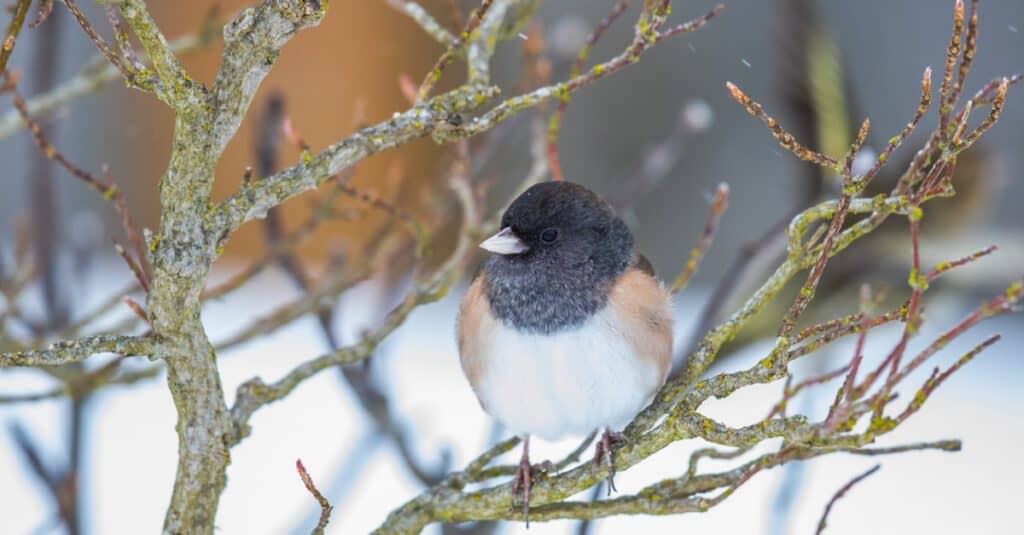
The greatest differences between a junco and a chickadee include their morphology and location. The junco is a small migratory bird from North America that may have a black cap on its head, usually has a solid color on the face and neck, but has a white breast and pink beak. The chickadee is a small non-migratory bird from the Americas, Europe, and Asia that may have a large head cap or black patch on its head, a path of gray or black on its throat, a white breast, light streaks on its face and a dark beak.
These differences need further explanations and comparisons before you can use them to understand what sets these birds apart. We’ll continue our examination with a look at all six of the most important differences below.
Junco vs Chickadee: Size
The average junco is a little larger than a chickadee. The junco can weigh anywhere between 0.5 and 1.06 ounces, while it can measure anywhere from 5.1 to 6.9 inches long. This isn’t much larger than the chickadee, but it’s noticeable.
The chickadee weighs anywhere between 0.3 and 0.4 ounces, and it also measures about 2.4 to 5.9 inches in length. A small chickadee will stand out against an average-sized junco. However, when both birds are around their biggest length, it’s very difficult to say which is which by size alone.
Junco vs Chickadee: Morphology
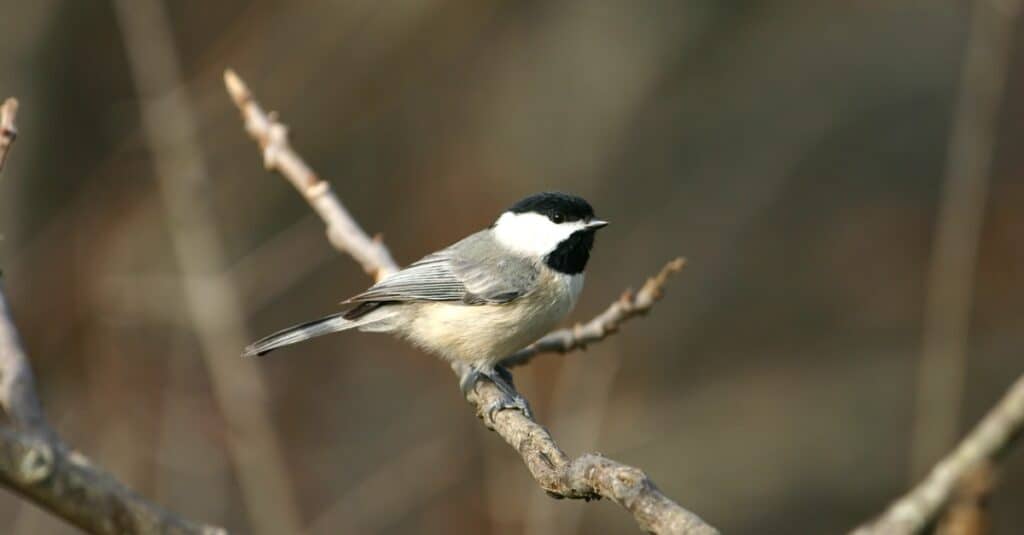
iStock.com/lgunderson
The birds have significant morphological differences. Some species of the junco may have a black patch on the top of their head.
Making matters more difficult is the fact that their heads and necks can be one solid color, so a junco may have a black patch on the head as well as a slate gray neck. It may appear as one color all around. Juncos will often have a white breast, a puffy and rounded appearance, as well as a pink beak.
Chickadees can take many forms. One of the common types is the black-capped chickadee, a bird with a black cap on its head, a black throat patch, and white streaks from its beak to its flanks. This bird will often have gray or light-colored markings on the wings and tail along with a dark-colored, usually black, beak.
As you can see, these birds are very unique once you compare certain aspects of their bodies.
Junco vs Chickadee: Location
The junco is a migratory bird from North America. However, the chickadee and its family are found in North America and sometimes in Central America. Yet, when the bird is found outside of the U.S., it’s called a tit instead. These birds do not migrate like the junco.
Junco vs Chickadee: Call

Rob Palmer Photography/Shutterstock.com
The junco bird uses a multi-note call with chips and trills for a few seconds at a time. This is contrary to the call that one gets from the chickadee, a bird whose name in the U.S. is a bit of an onomatopoeia. Their alarm call sounds like the birds are saying “chick-a-dee-dee-dee”, and it’s very noticeable.
Junco vs Chickadee: Genus
The junco bird comes from the genus Junco, which has five different species. However, the chickadee belongs to the genus, Poecile, and it has seven different species. The grey-headed chickadee is referred to as the Siberian tit in Eurasia, though.
Junco vs Chickadee: Diet
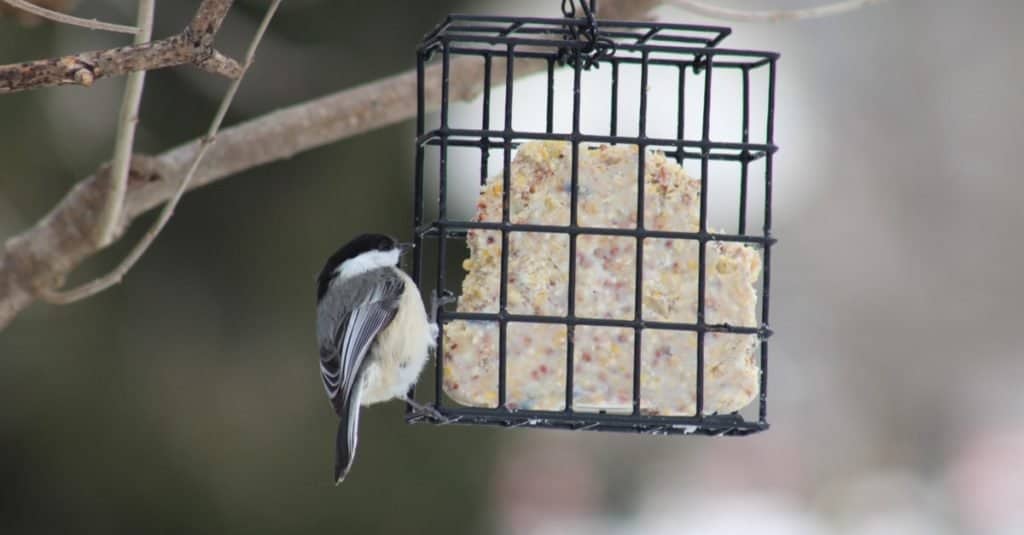
Wade Lamb/Shutterstock.com
The junco is a bird that primarily survives by eating insects and seeds. It is not known to cache food. Instead, it will often forage for it on the ground, sometimes kicking and scratching the dirt to find the right meal.
The chickadee is a primarily granivorous creature that tends to eat insects, fruits, and nuts. This bird is known for creating huge caches of seeds that help them survive throughout the winter. Its memory is so great that it can stash thousands of seeds and use its spatial memory to find them once again.
All in all, the chickadee and the junco are two interesting birds that share some similarities and a lot of differences. Now that we have focused on what separates these two animals, you should have no problem telling which bird you’re seeing or hearing in the wild.
More from A-Z Animals
Small birds can be very hard to tell apart. They are quick, skittish, and share similar traits. However, when you have the time to examine each bird for its unique characteristics, you can find enough differences to confidently state the creature’s identity. We are going to try to cultivate that level of familiarity by looking at a comparison between a junco and a chickadee.
By focusing on six key differences between these types of birds, we’ll help you learn what makes these birds unique.
Comparing a Junco and a Chickadee

A-Z-Animals.com
| Junco | Chickadee | |
|---|---|---|
| Size | Weight: 0.5-1.06 oz Length: 5.1- 6.9 in |
Weight: 0.3 to 0.4 oz Length: 2.4-5.9 in |
| Morphology | – Can have a black patch on the top of its head – Sometimes has one solid color on the head and neck – Usually lacks the white streaks on the side of its face – White breast – Pink beak – Puffy appearance |
– May have a head cap or dark-colored patch that is black or gray – Dark throat patch – White breast – Light-colored streaks on the face with markings on the tail – Dark or black beak |
| Location | – North America – Migrates |
– North America, Europe, and Asia – Typically, they do not migrate |
| Call | – Simply chips and trills several notes for a few seconds at a time | – Alarm call is often written as “chick-a-dee-dee-dee” |
| Genus | – Junco – Five different species and subspecies |
– Poecile – Several species, but not all of them are referred to as chickadee – Outside of the U.S., they are called tits. |
| Diet | – Insects and seeds – They do not cache food – Forages for food |
– Granivorous, but also eat insects, fruits, and nuts – Creates caches of seeds throughout their range to survive the winter |
The 6 Key Differences Between a Junco vs Chickadee

The greatest differences between a junco and a chickadee include their morphology and location. The junco is a small migratory bird from North America that may have a black cap on its head, usually has a solid color on the face and neck, but has a white breast and pink beak. The chickadee is a small non-migratory bird from the Americas, Europe, and Asia that may have a large head cap or black patch on its head, a path of gray or black on its throat, a white breast, light streaks on its face and a dark beak.
These differences need further explanations and comparisons before you can use them to understand what sets these birds apart. We’ll continue our examination with a look at all six of the most important differences below.
Junco vs Chickadee: Size
The average junco is a little larger than a chickadee. The junco can weigh anywhere between 0.5 and 1.06 ounces, while it can measure anywhere from 5.1 to 6.9 inches long. This isn’t much larger than the chickadee, but it’s noticeable.
The chickadee weighs anywhere between 0.3 and 0.4 ounces, and it also measures about 2.4 to 5.9 inches in length. A small chickadee will stand out against an average-sized junco. However, when both birds are around their biggest length, it’s very difficult to say which is which by size alone.
Junco vs Chickadee: Morphology

iStock.com/lgunderson
The birds have significant morphological differences. Some species of the junco may have a black patch on the top of their head.
Making matters more difficult is the fact that their heads and necks can be one solid color, so a junco may have a black patch on the head as well as a slate gray neck. It may appear as one color all around. Juncos will often have a white breast, a puffy and rounded appearance, as well as a pink beak.
Chickadees can take many forms. One of the common types is the black-capped chickadee, a bird with a black cap on its head, a black throat patch, and white streaks from its beak to its flanks. This bird will often have gray or light-colored markings on the wings and tail along with a dark-colored, usually black, beak.
As you can see, these birds are very unique once you compare certain aspects of their bodies.
Junco vs Chickadee: Location
The junco is a migratory bird from North America. However, the chickadee and its family are found in North America and sometimes in Central America. Yet, when the bird is found outside of the U.S., it’s called a tit instead. These birds do not migrate like the junco.
Junco vs Chickadee: Call

Rob Palmer Photography/Shutterstock.com
The junco bird uses a multi-note call with chips and trills for a few seconds at a time. This is contrary to the call that one gets from the chickadee, a bird whose name in the U.S. is a bit of an onomatopoeia. Their alarm call sounds like the birds are saying “chick-a-dee-dee-dee”, and it’s very noticeable.
Junco vs Chickadee: Genus
The junco bird comes from the genus Junco, which has five different species. However, the chickadee belongs to the genus, Poecile, and it has seven different species. The grey-headed chickadee is referred to as the Siberian tit in Eurasia, though.
Junco vs Chickadee: Diet

Wade Lamb/Shutterstock.com
The junco is a bird that primarily survives by eating insects and seeds. It is not known to cache food. Instead, it will often forage for it on the ground, sometimes kicking and scratching the dirt to find the right meal.
The chickadee is a primarily granivorous creature that tends to eat insects, fruits, and nuts. This bird is known for creating huge caches of seeds that help them survive throughout the winter. Its memory is so great that it can stash thousands of seeds and use its spatial memory to find them once again.
All in all, the chickadee and the junco are two interesting birds that share some similarities and a lot of differences. Now that we have focused on what separates these two animals, you should have no problem telling which bird you’re seeing or hearing in the wild.

